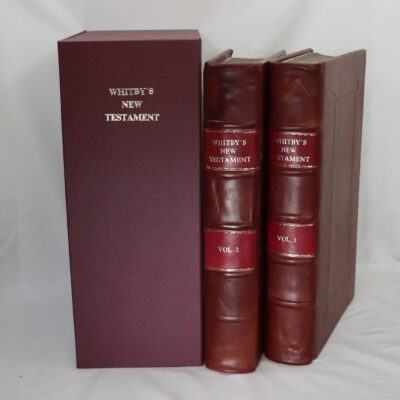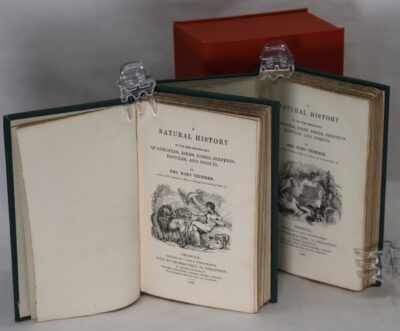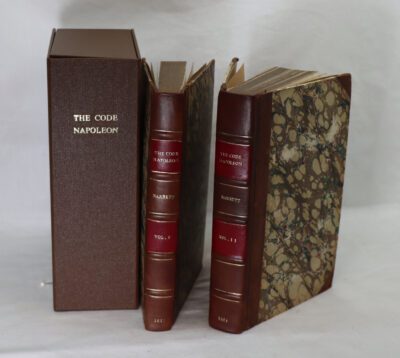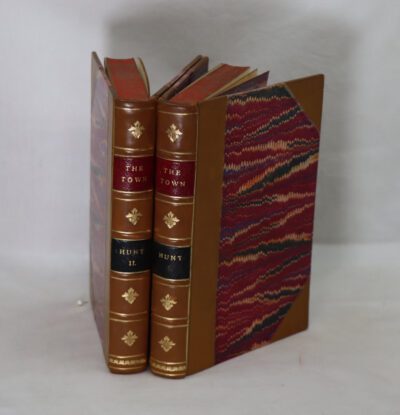Elements of Logic. Whately.
By Richard Whately DD
Printed: 1836
Publisher: R Fellowes. London
| Dimensions | 16 × 24 × 4 cm |
|---|---|
| Language |
Language: English
Size (cminches): 16 x 24 x 4
Condition: Fine (See explanation of ratings)
Your items
Item information
Description
Tan calf spine with white title plate and black lettering. Tan, orange and grey marbled boards.
F.B.A. provides an in-depth photographic presentation of this item to stimulate your feel and touch. More traditional book descriptions are immediately available.
Whately was a prolific writer, a successful expositor and Protestant apologist in works that ran to many editions and translations. His Elements of Logic (1826) was drawn from an article “Logic” in the Encyclopædia Metropolitana. The companion article on “Rhetoric” provided Elements of Rhetoric (1828).] In these two works Whately introduced erotetic logic.
In 1818 Whately contributed his article on Logic to the Encyclopedia Metropolitana. To the same work he also contributed the original outline of his Elements of Rhetoric. These writings were too important and useful to be kept shut up in the huge miscellany of learning in which they at first appeared, and were, on urgent demand, republished in 1825. The former, in which, as the late Prof. Spalding said, he has expounded the Aristotelian or syllogistic logic with admirable clearness and method, and illustrated it with characteristic sagacity, was severely commented upon by Sir G. C. Lewis, by George Bentham, nephew of the philosopher of Westminster, and notably by Sir W. Hamilton in his paper (subsequently republished) in the Edinburgh Review for April, 1833. Even by these opponents it is admitted that “a new life was suddenly communicated to the study” of logic by the publication of this work; and we may safely trust the decision of John S. Mill, that in it the student will find stated with philosophical precision, and explained with remarkable perspicuity, the whole of the common doctrine of the “syllogism.” The latter work, that on Rhetoric, was immediately accepted as a text-book. De Quincey early acknowledged “the acuteness and originality which illuminate every part of the book,” and asserted that “in any elementary work it has not been our fortune to witness a rarer combination of analytical acuteness with severity of judgment.” In 1819 Whately issued anonymously his ingeniously grave logical satire, on scepticism, entitled Historic Doubts Relative to the Existence of Napoleon Bonaparte. In 1822 appeared his Bampton Lectures, on The Use and Abuse of Party Feeling in Religion. This subject is treated with delicacy, discrimination, and liberality, and the series has been frequently reissued.
In 1825 Whately published a series of Essays on Some of the Peculiarities of the Christian Religion, followed in 1828 by a second series On some of the Difficulties in the Writings of St Paul, and in 1830 by a third On the Errors of Romanism traced to their Origin in Human Nature. In 1837 he wrote his handbook of Christian Evidences, which was translated during his lifetime into more than a dozen languages. In the Irish context, the Christian Evidences was adapted to a form acceptable to Catholic beliefs, with the help of James Carlile.
Richard Whately (1 February 1787 – 8 October 1863) was an English academic, rhetorician, logician, philosopher, economist, and theologian who also served as a reforming Church of Ireland Archbishop of Dublin. He was a leading Broad Churchman, a prolific and combative author over a wide range of topics, a flamboyant character, and one of the first reviewers to recognise the talents of Jane Austen.
Want to know more about this item?

Share this Page with a friend












